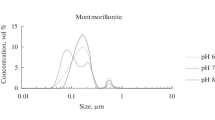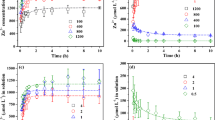Abstract
Natural nanomaterials, which play a very important role in environmental processes, are so far poorly studied. Firstly, the separation of nanoparticles from the bulk sample is a challenge. Secondly, the absence of reference natural nanomaterials makes it impossible to compare the results obtained by different researchers and develop a unified methodology for the separation and characterization of natural nanomaterials. Therefore, the development of reference natural nanomaterials is an urgent need of the environmental analytical chemistry. In this work, mineral nanoparticles (kaolinite, montmorillonite, muscovite, and quartz) have been studied as potential reference natural nanomaterials. A set of analytical methods including coiled-tube field-flow fractionation, scanning electron microscopy, dynamic light scattering, laser diffraction, inductively coupled plasma atomic emission, and mass spectrometry are applied to the separation and characterization of nanoparticles. It has been shown by laser diffraction that 93–98% of separated mineral nanoparticles are in the size range from about 40 to 300 nm, while 2–7% have size up to 830 nm. The size range of particles is confirmed by electron microscopy. Major (Al, Na, K, Ca, Fe), trace (Ti, Co, Cu, Zn, Tl, Pb, Bi, etc.), and rare earth elements have been determined in the suspensions of kaolinite, montmorillonite, and muscovite nanoparticles. Based on Al content, the concentration of mineral nanoparticles in suspensions is estimated. Agglomeration stability (consistency of size distribution) of nanoparticles at pH 6–8 is assessed. It has been shown that muscovite nanoparticles are stable at pH 7–8, whereas montmorillonite nanoparticles are stable only at pH 8 for at least 4 weeks. A noticeable agglomeration of kaolinite nanoparticles is observed at pH 6–8. Due to the low concentration of quartz nanoparticles, their characterization and stability assessment are hindered. The challenges of the development of reference natural nanomaterials are discussed.
Graphical abstract






Similar content being viewed by others
Notes
1 Tg = 1012 g
References
Buzea C, Pacheco II, Robbie K. Nanomaterials and nanoparticles: sources and toxicity. Biointerphases. 2007;2:MR17–71. https://doi.org/10.1116/1.2815690.
Hochella MF, Mogk DW, Ranville J, Allen IC, Luther GW, Marr LC, et al. Natural, incidental, and engineered nanomaterials and their impacts on the Earth system. Science (80- ). 2019;363:eaau8299. https://doi.org/10.1126/science.aau8299.
Keller AA, Lazareva A. Predicted releases of engineered nanomaterials: from global to regional to local. Environ Sci Technol Lett. 2013;1:65–70. https://doi.org/10.1021/ez400106t.
Xu J, Campbell JM, Zhang N, Hickey WJ, Sahai N. Did mineral surface chemistry and toxicity contribute to evolution of microbial extracellular polymeric substances? Astrobiology. 2012;12:785–98. https://doi.org/10.1089/ast.2011.0776.
Sahai N, Kaddour H, Dalai P, Wang Z, Bass G, Gao M. Mineral surface chemistry and nanoparticle-aggregation control membrane self-assembly. Sci Rep. 2017;7:1–13. https://doi.org/10.1038/srep43418.
Maters EC, Delmelle P, Bonneville S. Atmospheric processing of volcanic glass: effects on iron solubility and redox speciation. Environ Sci Technol. 2016;50:5033–40. https://doi.org/10.1021/acs.est.5b06281.
Olgun N, Duggen S, Andronico D, Kutterolf S, Croot PL, Giammanco S, et al. Possible impacts of volcanic ash emissions of Mount Etna on the primary productivity in the oligotrophic Mediterranean Sea: results from nutrient-release experiments in seawater. Mar Chem. 2013;152:32–42. https://doi.org/10.1016/j.marchem.2013.04.004.
Lindenthal A, Langmann B, Pätsch J, Lorkowski I, Hort M. The ocean response to volcanic iron fertilisation after the eruption of Kasatochi volcano: a regional-scale biogeochemical ocean model study. Biogeosciences. 2013;10:3715–29. https://doi.org/10.5194/bg-10-3715-2013.
Bains S, Norris RD, Corfield RM, Faul KL. Termination of global warmth at the Palaeocene/Eocene boundary through productivity feedback. Nature. 2000;407:171–4. https://doi.org/10.1038/35025035.
Sigman DM, Boyle EA. Glacial/interglacial variations in atmospheric carbon dioxide. Nature. 2000;407:859–69.
Hochella MF, Aruguete D, Kim B, Madden AS. Naturally occurring inorganic nanoparticles: general assessment and a global budget for one of earth’s last unexplored major geochemical components. In: Nature’s Nanostructures. Pan Stanford Publishing Pte. Ltd., 2012. pp. 1–42.
Wang Y. Nanogeochemistry: nanostructures, emergent properties and their control on geochemical reactions and mass transfers. Chem Geol. 2014;378–379:1–23.
Ermolin MS, Fedotov PS, Ivaneev AI, Karandashev VK, Fedyunina NN, Eskina VV. Isolation and quantitative analysis of road dust nanoparticles. J Anal Chem. 2017;72:520–32. https://doi.org/10.1134/S1061934817050057.
Ermolin MS, Fedotov PS, Karandashev VK, Shkinev VM. Methodology for separation and elemental analysis of volcanic ash nanoparticles. J Anal Chem. 2017;72:533–41. https://doi.org/10.1134/S1061934817050069.
Fedotov PS, Ermolin MS, Katasonova ON. Field-flow fractionation of nano- and microparticles in rotating coiled columns. J Chromatogr A. 2015;1381:202–9. https://doi.org/10.1016/j.chroma.2014.12.079.
Karandashev VK, Khvostikov VA, Nosenko SV, Burmii ZP. Stable highly enriched isotopes in routine analysis of rocks, soils, grounds, and sediments by ICP-MS. Inorg Mater. 2017;53:1432–41. https://doi.org/10.1134/S0020168517140084.
Liu L, Hu Y, Min F, Zhang M, Song S. Characterizations and stability of colloidal coal-measure kaolinite in aqueous suspensions: a review. Surf Rev Lett. 2013;20:1–9. https://doi.org/10.1142/S0218625X13300013.
Bolland MDA, Posner AM, Quirk JP. pH-independent and pH-dependent surface charges on kaolinite. Clay Clay Miner. 1980;28:412–8. https://doi.org/10.1346/CCMN.1980.0280602.
Sposito G (1984) The surface chemistry of soils. Oxford University Press, New York
Carroll-Webb SA, Walther JV. A surface complex reaction model for the pH-dependence of corundum and kaolinite dissolution rates. Geochim Cosmochim Acta. 1988;52:2609–23. https://doi.org/10.1016/0016-7037(88)90030-0.
Kosmulski M (2020) The pH dependent surface charging and points of zero charge. VIII Update Adv Colloid Interface Sci 275:102064.
Pate K, Safier P. Chemical metrology methods for CMP quality. In: Advances in chemical mechanical planarization (CMP). Elsevier Inc., 2016. pp 1–325.
Ermolin MS, Fedotov PS, Malik NA, Karandashev VK. Nanoparticles of volcanic ash as a carrier for toxic elements on the global scale. Chemosphere. 2018;200:16–22. https://doi.org/10.1016/j.chemosphere.2018.02.089.
Ermolin MS, Dzherayan TG, Vanifatova NG. Stability of volcanic nanoparticles using combined capillary zone electrophoresis and laser diffraction. Environ Chem Lett. 2021;19:751–62. https://doi.org/10.1007/s10311-020-01087-6.
Ivaneev AI, Faucher S, Ermolin MS, Karandashev VK, Fedotov PS, Lespes G. Separation of nanoparticles from polydisperse environmental samples: comparative study of filtration, sedimentation, and coiled tube field-flow fractionation. Anal Bioanal Chem. 2019;411:8011–21. https://doi.org/10.1007/s00216-019-02147-9.
Ermolin MS, Fedotov PS, Ivaneev AI, Karandashev VK, Burmistrov AA, Tatsy YG. Assessment of elemental composition and properties of copper smelter-affected dust and its nano- and micron size fractions. Environ Sci Pollut Res. 2016;23:23781–90. https://doi.org/10.1007/s11356-016-7637-6.
Fedotov PS, Ermolin MS, Karandashev VK, Ladonin DV. Characterization of size, morphology and elemental composition of nano-, submicron, and micron particles of street dust separated using field-flow fractionation in a rotating coiled column. Talanta. 2014;130:1–7. https://doi.org/10.1016/j.talanta.2014.06.040.
Ermolin MS, Fedotov PS, Ivaneev AI, Karandashev VK, Fedyunina NN, Burmistrov AA. A contribution of nanoscale particles of road-deposited sediments to the pollution of urban runoff by heavy metals. Chemosphere. 2018;210:65–75. https://doi.org/10.1016/j.chemosphere.2018.06.150.
Acknowledgements
The authors are indebted to Prof. Olga B. Rogova (V.V. Dokuchaev Soil Science Institute, Moscow, Russia) for the provided samples of minerals.
Funding
The work is supported by the Russian Science Foundation (project no. 20-73-00299). The study corresponds to the research topic no. 0116-2019-0010 of Vernadsky Institute of Geochemistry and Analytical Chemistry, Russian Academy of Sciences.
Author information
Authors and Affiliations
Corresponding author
Ethics declarations
Conflict of interest
The authors declare no competing interests.
Additional information
Publisher’s note
Springer Nature remains neutral with regard to jurisdictional claims in published maps and institutional affiliations.
Supplementary information
ESM 1
(PDF 435 kb)
Rights and permissions
About this article
Cite this article
Ermolin, M.S., Ivaneev, A.I., Fedyunina, N.N. et al. Natural silicate nanoparticles: separation, characterization, and assessment of stability and perspectives of their use as reference nanomaterials. Anal Bioanal Chem 413, 3999–4012 (2021). https://doi.org/10.1007/s00216-021-03351-2
Received:
Revised:
Accepted:
Published:
Issue Date:
DOI: https://doi.org/10.1007/s00216-021-03351-2




